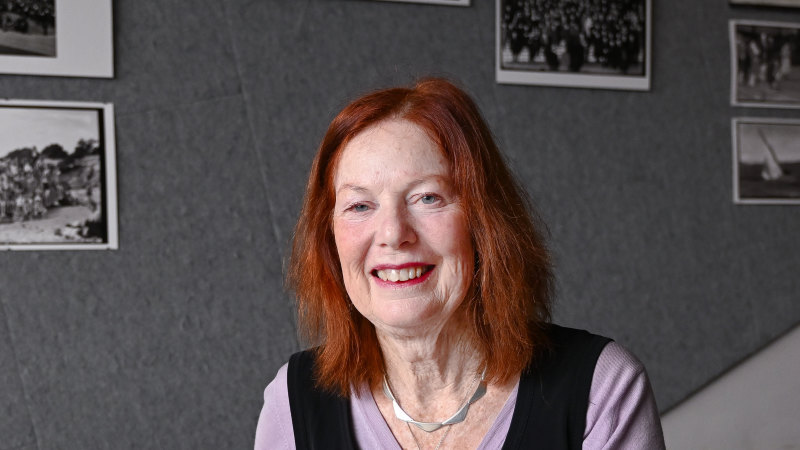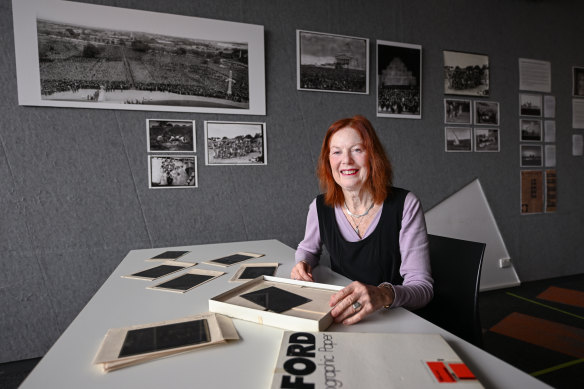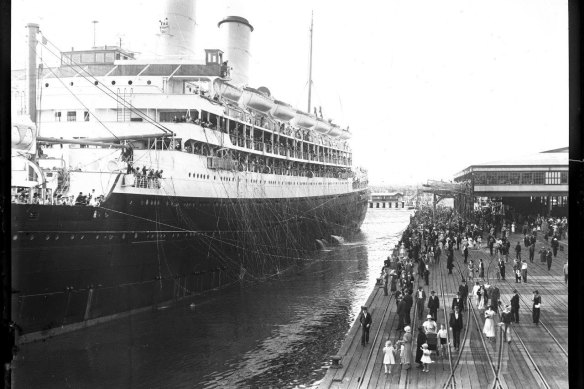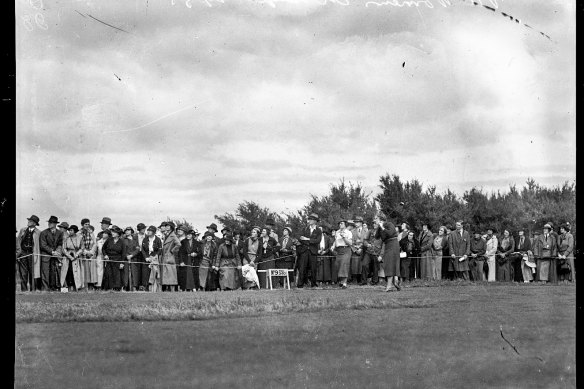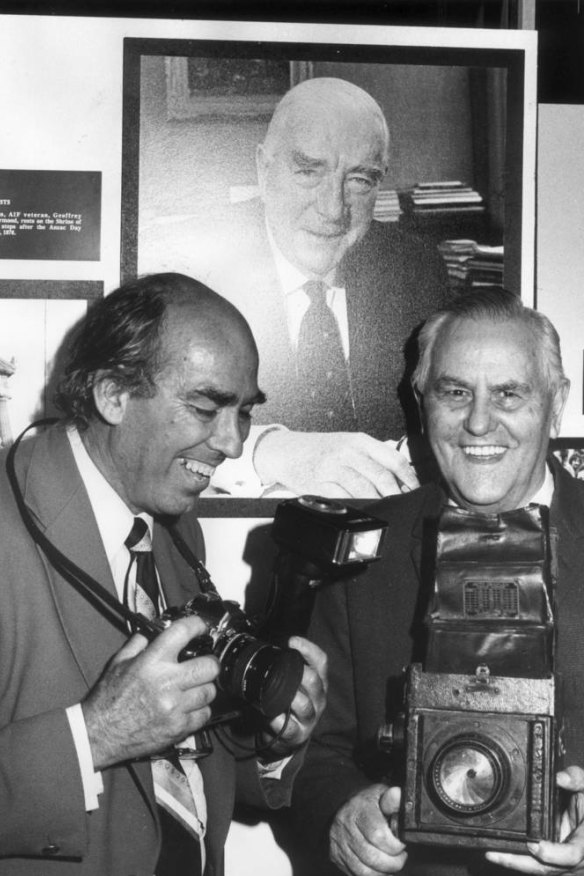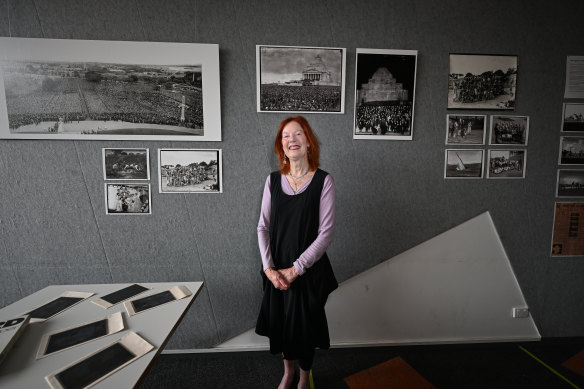By Cara Waters
Save articles for later
Add articles to your saved list and come back to them any time.
Louise McKenzie was cleaning out the garage after her husband died when she found a collection of glass plate negatives.
The negatives turned out to be old photographs of Melbourne dating back to the 1930s. McKenzie has spent the last three years uncovering the stories behind them.
Louise McKenzie discovered a hidden trove of negatives in her garage which turned out to be for photographs of Melbourne taken nearly 100 years ago. Credit: Joe Armao
The 240 negatives depict a range of moments from Melbourne’s history, from St Kilda swimmers on Christmas morning in 1933 to a fire at the Cathedral Hotel on Swanston Street in 1936.
“My husband [Ian McKenzie] was a bit of a magpie,” McKenzie says. “He was an architectural photographer and he must have picked these up in the ’90s at a garage sale or the Camberwell Market.”
The negatives had sat untouched in an old box in the garage for more than 20 years and when McKenzie found them in the clean-out, she knew she was onto something special.
“They were obviously wonderful moments of Melbourne and Victoria,” she says. “The photographer had scratched details on the back so I could tell where each photo was from.”
McKenzie took the negatives into the East Melbourne Library to start the process of digitising, scanning and printing the photographs and trying to discover who had taken them.
McKenzie, along with history lovers Ernie Ward and Fiona Collyer, signed up as City of Melbourne volunteers and joined forces with the council’s libraries’ community heritage team leader Linda Longley and local history librarian Fiona Campbell.
They spent more than three years trying to unlock the mysteries of the negative collection.
“I wanted to be involved as I didn’t want them to end up in the tip,” McKenzie says. “When we started to do the scans it was just so exciting because they were of an era that I could still relate to.”
The first negative they scanned was of the RMS Orford ship leaving Station Pier in Port Melbourne with streamers flying from the deck and crowds lining the shore to wave goodbye.
“It was a fascinating time because it was the Melbourne Centenary in 1934 and 1935 and it was also the Depression and between the wars,” McKenzie says. “In the pictures that show children there are often some with shoes and some with bare feet. Contrast that with the marvellous electric lights put up in Melbourne for the Centenary which were spectacular.”
Many of the photographs have interesting stories behind them, which the team uncovered by going through newspaper archives, including those of The Age.
“The Orford was carrying our test cricket and Davis Cup tennis teams to the UK, including Sir Donald Bradman,” McKenzie says. “The press were on board and radioed reports daily of the various activities including who got seasick. Joan Hartigan the Australian Open winner was reported as discarding her bright blue shorts for bright blue bathers and being first into the swimming pool.”
A photograph of the dedication of the Shrine of Remembrance stands out because of the few women standing at the back of a sea of men in suits.
“They are facing away from the Shrine and are holding up their powder compacts like a periscope so they can see over the backs of the men,” McKenzie says.
RMS Orford leaving Station Pier in Port Melbourne in 1934.Credit: Hugh Bull, The McKenzie Collection
A photograph of a women’s golf match at the Royal Melbourne Golf Course in 1934 between Australia and Great Britain sheds light on a “huge controversy” at the time about women wanting to play golf without wearing stockings.
“One of them developed liquid makeup for legs so they looked nice and brown but it contained titanium so they had to abandon it in the war effort,” McKenzie says.
Eventually, women were able to play golf wearing socks rather than stockings.
An ongoing mystery was who had taken the photographs.
“It took a couple of years but we finally tracked down the photographer,” McKenzie says. “I always thought he would have to be someone involved with the media or the press because of the number of significant events captured”.
The Victorian Women’s Golf Championship in August 1935. Credit: Hugh Bull, The McKenzie Collection
McKenzie and her team got in touch with The Age’s librarian, Michelle Stillman, who found one old page of the newspaper that featured three photos from McKenzie’s collection.
They found more and more of the photographs in The Age’s archives and realised the photographer was the masthead’s first full-time photographer, Hugh Bull.
“He had a job on Fleet Street [in London] but the company folded, so he came out to Australia with his wife, children and his camera, and within three days, he got a job at The Age,” McKenzie says.
Bull arrived in 1927 and was initially put on probation at The Age for three months, but his status changed to full time after he demonstrated his worth during a day at the races.
Bull and the other photographers assigned to cover the meeting had limited visibility because the “foul” Melbourne weather made it difficult to photograph. While the others aimed their cameras and tried to take shots, he panned his camera in time with the horses passing by.
Photographer Dennis Bull with his father Hugh Bull, who was employed as the first photographer at The Age.
Bull was the only photographer to return with useable images of the winning horses that day. He ended up working as a photographer for The Age for 31 years.
He produced a dynasty of press photographers – sons Dennis, Peter and Geoff all work in the trade and grandson Colin followed in their footsteps. Son Ken worked as a photo engraver.
Bull passed away in his late 90s.
Stillman says when The Age moved from its building in Collins Street to Spencer Street in 1969, any negatives from before the 1950s, which included Bull’s glass plate negatives, were discarded.
“The new building at 250 Spencer Street was purpose built, and supposed to be the dawn of a modern age, where we didn’t need bulky old glass plate negatives cluttering up our new-beaut building,” she says.
“The decision makers didn’t consider the history the collection represented, just the space they took up. It’s heartbreaking to think of the lost history on those glass plates.”
Stillman says she was astonished to find out about McKenzie’s collection of negatives.
“Considering that people chuck out photo albums of their own family history, to have … heavy but fragile glass plate negatives of unidentified images survive is amazing,” she says.
McKenzie says the process has been a labour of love and is a great example of the joy of volunteering.
The exhibition of 50 photographs is being held at the East Melbourne library. Credit: Joe Armao
“Whenever we showed anyone these photographs they got so excited about it so we thought we’d do an exhibition,” she says.
The exhibition, which has been named the McKenzie Collection, is being held at the East Melbourne Library and includes 50 photographs with some printed in silver gelatin, which was a commonly used process at the time.
McKenzie says subsequent garage clean-outs have uncovered an old grandfather clock, but not much else.
“I doubt I will find more,” she says. “But I will keep looking.”
The exhibition, Newsworthy: Melbourne in Photographs 1933-1936, is on at the East Melbourne Library and runs until 10 December.
The Morning Edition newsletter is our guide to the day’s most important and interesting stories, analysis and insights. Sign up here.
Most Viewed in National
Source: Read Full Article
